How to Change Your Fuel Injectors
-
Testing The Performance From The Fuel Injectors

-
listening Test
The listening test helps you spot injectors that don’t work. To do it, start the engine and allow your car to idle.
While the engine runs, put the tip of a long metal screwdriver against one of the fuel injectors. Lean in and put your ear on the handle of the screwdriver.
A clicking sound indicates a good injector. If you don’t hear anything, the injector may need to be cleaned or replaced.
Continue, checking each fuel injector. Make a note of which injectors are quiet.
-
Voltage Test
Leaks on or around your fuel injector can indicate that it has bad O-ring seals and it may need to be replaced.
-
Leak Test
Leaks can happen if the O-ring seals on a fuel injector wear out. To check for leaks, turn on the engine and let the car idle for a few minutes. Lean in and see if you notice the smell of gasoline.
Shine a flashlight or a work light under the hood and look for leaking gas. If you smell or spot leaks, one or more fuel injectors may need to be replaced.
-
Diagnostic Scanning
A diagnostic scanner can help you identify bad fuel injectors. Also called an onboard diagnostics (OBD) reader, this device can read the data your vehicle’s computer system stores. By doing so, it allows you to spot errors and problems.
Each scanner works a little differently. Refer to the manufacturer’s instructions to find out how to connect it to your vehicle and what to look for on the display.
-
Getting Rid Of The Pressure That Has Built Up Along The Fuel Lines
The first step in replacing a fuel injector is to relieve the pressure in the fuel system itself.
Skipping this step could result in a messy and dangerous project, so refer to your vehicle’s owner’s manual for specific instructions on how to depressurize the fuel system.
If the vehicle has been on recently, allow the engine to cool, then locate the fuel pump fuse or the relay that controls the fuel pump.
Don’t pull it just yet; start the engine and disconnect the fuse. If all goes well, the engine should sputter out due to a lack of pressurized fuel.
-
Disconnecting The Fuel Rails

Many fuel injection systems use a centralized fuel rail to route fuel to each injector. This will have to be removed to get to the injectors themselves, so disconnect the main fuel line feeding into the rail.
Some systems will have fuel lines at each end of the rail and they’ll both need to be removed to proceed. Once this is done, simply remove the bolts or screws and the rail should pop right off. Some vehicles will have an individual fuel line feeding into each injector, which you can remove one by one.
-
Undo The Fuel Injector
With the tops of the fuel injectors exposed, it’s now time to remove the wiring harness connected to each injector.
Either of the fuel injectors connected to the engine of your vehicle should have a plug that is attached to a wiring harness. In some cases, the wiring will be located on top of the fuel rail itself and should be removed before disconnecting the rail. These harnesses are usually held on by little more than a single spring, which you can pry out with a flathead screwdriver or similar implement.
The screwdriver- a flat-tip one- is placed in the area between the plug and the spring, then nudge so that the fuel injector is loose enough for removal. Make sure to hold onto this small metal spring, as it’s all too easy to misplace.
-
Pull Out The Fuel Injector From Their Position

A caution that you need to observe is to remove the fuel injectors gently while avoiding the use of too much force.
If you are not careful at this point, the fuel rail may be damaged by the excessive force you apply while removing the fuel injectors.
For starters, the O-ring seals that are on the nozzles of the fuel injectors need to be inspected before you take any other action.
They should be complete, otherwise, the O-ring might still be in the intake manifold. If the O-ring is not complete, you first have to remove it from the manifold before any other step.
For some vehicle models. The fuel injectors are secured onto the fuel rail of the engine using a retainer.
The retainer has to come off first before any other step. You can remove them by rocking the backward and forwards gently while avoiding damaging the rail.
After all these preparations, you should get a fuel injector puller and start pulling off the fuel injectors from their position.
You should also be gentle while doing this as too much force might cause them to break and some parts may fall onto the engine.
A fuel injector puller works to make your disconnection of the fuel injectors from their ports to be done much easier and also to avoid damage to the vehicle’s engine.
The last thing you want to deal with is damage to the engine of your vehicle. You can use it by sliding it just below the fuel injector housing’s lip and popping it out gently.
After you have successfully pulled out the fuel injector, the ports are seen as a large hole in the intake manifold of the engine.
You should be cautious not to allow anything to enter that space as correcting that will be quite stressful.
In the case of a throttle body, the disconnection of fuel injectors should be much simpler as all you need to do is pry them loose.
A caution that you need to observe is to remove the fuel injectors gently while avoiding the use of too much force.
If you are not careful at this point, the fuel rail may be damaged by the excessive force you apply while removing the fuel injectors.
For starters, the O-ring seals that are on the nozzles of the fuel injectors need to be inspected before you take any other action.
They should be complete, otherwise, the O-ring might still be in the intake manifold. If the O-ring is not complete, you first have to remove it from the manifold before any other step.
For some vehicle models. The fuel injectors are secured onto the fuel rail of the engine using a retainer.
The retainer has to come off first before any other step. You can remove them by rocking the backward and forwards gently while avoiding damaging the rail.
After all these preparations, you should get a fuel injector puller and start pulling off the fuel injectors from their position.
You should also be gentle while doing this as too much force might cause them to break and some parts may fall onto the engine.
A fuel injector puller works to make your disconnection of the fuel injectors from their ports to be done much easier and also to avoid damage to the vehicle’s engine.
The last thing you want to deal with is damage to the engine of your vehicle. You can use it by sliding it just below the fuel injector housing’s lip and popping it out gently.
After you have successfully pulled out the fuel injector, the ports are seen as a large hole in the intake manifold of the engine.
You should be cautious not to allow anything to enter that space as correcting that will be quite stressful.
In the case of a throttle body, the disconnection of fuel injectors should be much simpler as all you need to do is pry them loose.
-
Put In Place The New Fuel Injector
After the fuel injector is removed, installation is a walk in the park. Simply lubricate the seals on the new injector, replace it in the same hole you took it out of, and reconnect the wiring harness. Reattach the fuel rail or individual fuel lines, bolt everything down, and replace the fuel pump fuse. Once you start up the vehicle, the fuel system should repressurize itself.
Conclusion
If your fuel injector is damaged or you need to buy a fuel injector, you can come to our website to buy it. Our website will provide you with the most professional purchase guidance.
Here is the link you can check and buy aftermarket Fuel Injector online catalog.


